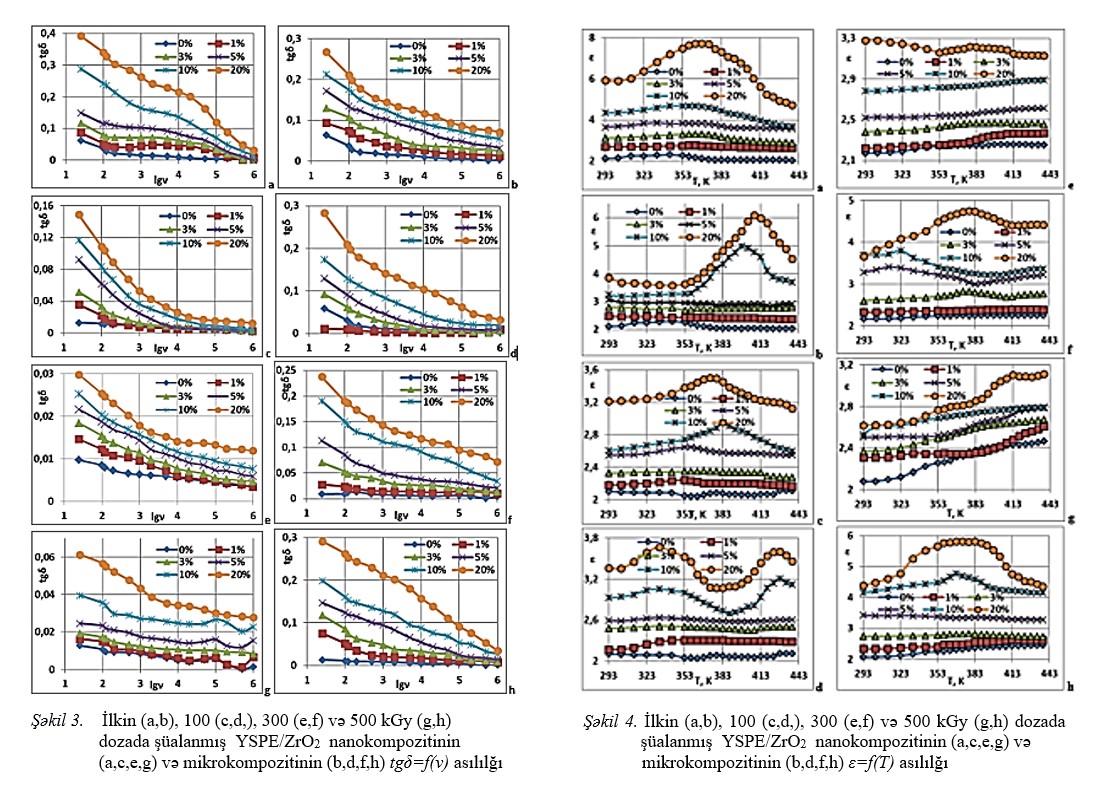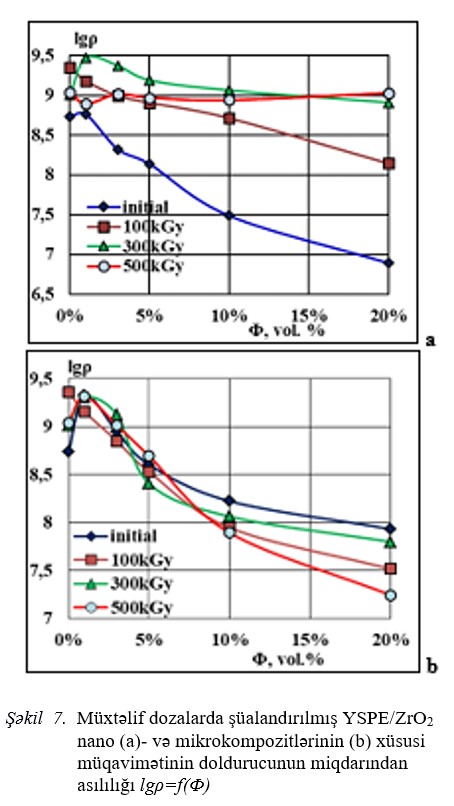ABSTRACT
The electrophysical properties of HDPE/ZrO2 composites based on micro- and nanosized zirconium dioxide (ZrO2) with high-density polyethylene (HDPE)
were studied. The influence of both filler sizes and gamma radiation on the electrophysical properties of HDPE /ZrO2 composites was investigated. It was shown
that the filler concentration in HDPE /ZrO2 nanocomposites is higher than in microcomposites, which leads to an increase in the effective interfacial surface area
and enhanced interaction between the components. An increase in the gamma radiation dose leads to an increase in the interfacial adhesive interaction and a decrease in the
mobility of macromolecules in the matrix due to an increase in the density of radiation crosslinks.
Keywords: HDPE /ZrO2 nano- and microcomposite, polyethylene, electrophysical properties, gamma radiation
DOI:10.70784/azip.2.2024344
Received: 27.09.2024
Internet publishing: 04.10.2024
AUTHORS & AFFILIATIONS
1. Ministry of Science and Education of the Republic of Azerbaijan, Institute of Radiation Problems, 9 B. Vahabzade, Baku, AZ 1143, Azerbaijan
2. Joint Institute Nuclear Research, Dubna, 141980, Russia
E-mail: musa_nuriev@mail.ru
Graphics and Images




Fig.1-2 Fig.3-4 Fig.5-6 Fig.7
|
[1] M. Kozako, R. Kido, N. Fuse, Y. Ohki, T. Okamoto, and T. Tanaka. Difference in Surface Degradation due to Partial Discharges between Polyamide Nanocomposite and Microcomposite, IEEE Conf. Electr. Insul. Dielectr. Phenomena, pp. 398-401, 2004. https://doi.org/10.1109/CEIDP.2004.1364271
[2] Sung Il Ahn, Chang Woo OHk, Jae Hyun Kim, Wang-Cheol Zin. Glass transition temperature of polymer nanocomposites: Prediction from the continuous-multilayer model, J Polym Sci Part B: Polym Phys, 2009, Volume 47, Issue 22, p.2281-2287. https://doi.org/10.1002/polb.21826
[3] D. Ma, Y.A. Akpalu, Y. Li, R.W. Siegel, L.S. Schadler. Effect of titania nanoparticles on the morphology of low density polyethylene, Journal of Polymer Science, Part B: Polymer Physics. 43: pp. 488-497. http://dx.doi.org/10.1002/Polb.20341
[4] Linda S. Schadler, J. Keith Nelson. Polymer nanodielectrics—Short history and future perspective, J. Appl. Phys. 128, 120902, 2020. https://doi.org/10.1063/5.0019865
[5] A.A. Nabiyev, A.Olejniczak, A.K.Islamov, A.Pawlukojc, O.I.Ivankov, M. Balasoiu, A.Zhigunov, M.A. Nuriyev, F.M. Guliyev, D.V.Soloviov, A.K. Azhibekov, A.S.Doroshkevich,O.Yu.Ivanshina, A.İ.Kuklin. Composite Films of HDPE with SiO2 and ZrO2 Nanoparticles: The Structure and Interfacial Effects. Nanomaterials, 2021, 11, 2673 (20р.). https://doi.org/10.3390/nano11102673
[6] M. F. Fréchette, M. Trudeau, H. D. Alamdari, and S. Boily. “Introductory remarks on Nano Dielectrics”, IEEE Conf. Electr. Insul. Dielectr. Phenomena, 2001, February, pp.808-818,. http://dx.doi.org/10.1109/CEIDP.2001.963496
[7] W. Peukert, H.C. Schwarzer, M. Gotzinger, L.Gunther and F. Stenger. 2003, Control of Particle Interfaces—The Critical Issue in Nanoparticle Technology. Advanced Powder Technology, 14, pp. 411-426. http://dx.doi.org/10.1163/156855203769710645
[8] P. Cousin and P. Smith. Dynamic mechanical properties of sulfonated polystyrene/alumina composites, J. Poly. Sc., 1994. Vol. 32, pp. 459-468, http://dx.doi.org/10.1002/polb.1994.090320307
[9] T. Tanaka, G. C. Montanari and R. Mülhaupt. Polymer Nanocomposites as Dielectrics and Electrical Insulation perspectives for Processing Technologies, Material Characterization and Future Applications, IEEE Trans. Dielectr. Electr. Insul., Vol. 11, pp. 763-783, 2004. http://dx.doi.org/10.1109/TDEI.2004.1349782
[10] T. J. Lewis, Nanometric Dielectrics, IEEE Transactions on Dielectrics and Electrical Insulation, Volume: 1, Issue: 5, October 1994, pp. 812-825, 1994. http://dx.doi.org/10.1109/94.326653
[11] J. C. Fothergill, J. K. Nelson and M. Fu. Dielectric Properties of Epoxy Nanocomposites containing TiO2, Al2O3 and ZnO fillers, IEEE Conf. Electr. Insul. Dielectr. Phenom., 2004. pp. 406-409, http://dx.doi.org/10.1109/CEIDP.2004.1364273
[12] D. Ma, R. W. Siegel, J-I. Hong, L. S. Schadler, E. Mårtensson and C. Önneby, Influence of nanoparticle surfaces on the electrical breakdown strength of nanoparticle-filled low-density polyethylene, J. Mater. Res.; March 2004, Vol. 19, № 3, pp. 857-863, http://dx.doi.org/10.1557/jmr.2004.19.3.857
[13] G S Zhukova, Z R Radjabov and G V Boykova. Features of the structure of interfacial layers in polymer composites, IOP Conf. Series: Materials Science and Engineering, 971, (2020), 032007, http://dx.doi.org/10.1088/1757-899X/971/3/032007
[14] E. Pérez & B. Lauke. Evaluation of the particle geometry and interphase influence on the filler-matrix debonding process. Materials Research Express, 2019,. Volume 6, Number 8, 085341. http://dx.doi.org/10.1088/2053-1591/ab2746
[15] K.L. Reifsnider, Modelling of the interphase in polymer-matrix composite material systems, Composites, Volume 25, Issue 7, 1994, Pages 461-469, https://doi.org/10.1016/0010-4361(94)90170-8
[16] Sahitya Movva, Reeshemah K. Burrell, Parisa Pooyan, Hamid Garmestani, Karl Jacob. Crystallographic texture evolution in ultra-high molecular weight polyethylene during uniaxial tension, February 2022, Polymer, 245(1):124649, http://dx.doi.org/10.1016/j.polymer.2022.124649
[17] A.A. Nabiyev, A. Olejniczak, A. Pawlukojc, M. Balasoiu, M. Bunoiu, A.M. Maharramov, M.A. Nuriyev, R.S. Ismayilova, A.K. Azhibekov, A.M. Kabyshev, O.I. Ivankov , T. Vlase, D.S. Linnik, A.A. Shukurova, O. Yu Ivanshina, V.A. Turchenko, A.I. Kuklin, Nano-ZrO2 filled high-density polyethylene composites: Structure, thermal properties, and the influence g-irradiation, Polymer Degradation and Stability, Volume 171, January 2020, 109042; https://doi.org/10.1016/j.polymdegradstab.2019.109042.
[18] Sáenz De Juano-Arbona, V., Vallés-Lluch, A., Contat-Rodrigo, L., & Ribes-Greus, A., Chemical and thermal characterization of high- and low-density irradiated polyethylenes. Journal of Applied Polymer Science, (2002), 86(8), 1953–1958. https://doi.org/10.1002/app.11110
[19] G. Stamboliev, E. Suljovrujic. A dielectric study of molecular relaxations in irradiated high density polyethylene. Polymer Degradation and Stability, 95, 2010, pp.593-599; https://doi.org/10.1016/j.polymdegradstab.2009.12.010
[20] Suljovrujic Edin. Some aspects of structural electrophysics of irradiated polyethylenes, Polymer, 2005, 46, (17), p.6353–6359, pp.6353–6359; https://doi.org/10.1016/j.polymer.2005.05.113
[21] A. Ribes-Greus & R.D. Calleja. 1989, Dielectric relaxations of high and low density irradiated polyethylenes. Journal of Applied Polymer Science, 38(6), pp.1127–1143. https://doi.org/10.1002/app.1989.070380611
|
